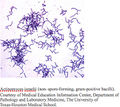Search results
From MicrobeWiki, the student-edited microbiology resource
Page title matches
- #REDIRECT [[Actinomyces naeslundii]]36 bytes (3 words) - 05:42, 5 May 2008
- ''Actinomyces naeslundii'' ...optimum growing temperature of 37°C, the normal human body temperature. ''Actinomyces naeslundii'' is commonly found in large numbers in the oral cavity and is a7 KB (996 words) - 19:35, 3 September 2010
- #REDIRECT [[Actinomyces israelii NEUF2011]]43 bytes (4 words) - 22:24, 5 October 2011
- '''Genus''': ''Actinomyces'' <br /> '''Species''': ''Actinomyces gerencseriae'' <br />14 KB (1,948 words) - 00:59, 11 December 2017
- Genus: ''Actinomyces'' [[File:Gram-stained_A._israelii.jpg|thumb|''Actinomyces israelii (non-spore-forming, Gram-positive bacilli). Image courtesy of Med12 KB (1,658 words) - 02:23, 2 November 2011

File:Actinomyces israelii Figure 1.jpg (304 × 272 (126 KB)) - 20:58, 1 November 2011
Page text matches

File:ActinoImage1.jpg Image of Gram-Positive Actinomyces israelii bacteria, strain X-372, under 1200X total magnification.(700 × 460 (51 KB)) - 16:00, 2 March 2022
File:Gram-stain of "A. israelii''.jpg ''Actinomyces israelii'' and ''Propionibacterium acnes'' published in ''Arquivos em Odont(150 × 105 (17 KB)) - 18:10, 1 November 2011- '''''[[Actinomyces israelii NEUF2011]]'''''<br>792 bytes (100 words) - 19:53, 14 October 2011
- ''Actinomyces naeslundii'' ...optimum growing temperature of 37°C, the normal human body temperature. ''Actinomyces naeslundii'' is commonly found in large numbers in the oral cavity and is a7 KB (996 words) - 19:35, 3 September 2010
- '''Genus''': ''Actinomyces'' <br /> '''Species''': ''Actinomyces gerencseriae'' <br />14 KB (1,948 words) - 00:59, 11 December 2017
- Genus: ''Actinomyces'' [[File:Gram-stained_A._israelii.jpg|thumb|''Actinomyces israelii (non-spore-forming, Gram-positive bacilli). Image courtesy of Med12 KB (1,658 words) - 02:23, 2 November 2011
- The taxa Pseudopropionibacterium propionicum was originally known as Actinomyces propionicus, then renamed Arachnia propionica (1). Until 2018, Pseudopropio ...ce homology with the 16S rRNA of other taxa, such as Actinomyces bovis and Actinomyces viscosus, that it more closely resembles morphologically or pathologically13 KB (1,873 words) - 15:00, 7 December 2020
- ...]</sup>. It is a Gram positive bacterium that bears semblance to other <i>Actinomyces</i> species, but the Gram positivity of the bacteria has been noted to dimi ...segment into coccoid or bacillus forms, not unlike the closely related <i>Actinomyces</i> genus. <sup>[[#References|[1]]]</sup><sup>[[#References|[2]]]</sup><sup8 KB (1,219 words) - 06:58, 23 September 2016
- ...amed ''A. dentocariosus'' because of the morphological similarities with ''Actinomyces'' species found in the mouth. His study of the isolate showed that it was a ...d, as a pathogen, <ref name=f/> due to its similarities in morphology to ''Actinomyces'' and ''Nocardia'', which have pathogenic members. <ref name=c/> Isolates o15 KB (2,278 words) - 04:34, 23 September 2016
- ...uman mouth flora in 1949.The bacteria was thought to be part of the groups Actinomyces dentocariosus, Nocardia dentocariosus, and Nocardia salivae until a separat3 KB (465 words) - 21:18, 16 December 2013
- ...us'', ''Streptococcus morbillorum''<sup>[[#References|[11]]]</sup>. and ''Actinomyces odontolyticus''<sup>[[#References|[12]]]</sup>. . ...''Streptoccus'', and are associated with the 'purple complex' (along with Actinomyces odontolyticus) which is while not as associated with periodontitis as the r13 KB (1,815 words) - 21:56, 22 September 2016
- ...ocariosa<i> coaggregates with Actinomyces species to form strong biofilms, Actinomyces spp. use Type 2-fimbrial adhesins <sup>[[#References|[7]]]</sup>. ...species are the most abundant followed by Haemophilus, Gemella, Rothia and Actinomyces species <sup>[[#References|[8]]]</sup>, <sup>[[#References|[14]]]</sup>. Ne16 KB (2,300 words) - 07:27, 23 September 2016
- ...hment of organisms [[#References|[1]]]. Species including ''Streptococcus, Actinomyces, Haemophilus, Neisseria'' and ''Veillonella'', most of which are Gram posit ...promoting inflammation [[#References|[9]]]. In gingivitis, Gram negative ''Actinomyces'' species predominate over Gram positive ''Streptococcus'' species [[#Refer10 KB (1,335 words) - 20:28, 29 September 2015
- other names: ''actinomyces griseus'' ...That same year, Albrez Schatz, an assistant of Dr. Waksman, isolated two actinomyces strains which proved to be identical to the strain discovered in 1915, yet17 KB (2,404 words) - 03:36, 20 August 2010
- ...tion between ''C. ochracea'' and ''F. nucleatum'', ''Streptococcus'' and ''Actinomyces'' species (6). Simple sugars, such as L-rhamnose, β-methy-D-galactoside, ...to its receptors (6). ''C. ochracea'' binds to 16 members of the genera ''Actinomyces'', ''Rothia'', and ''Streptococcus''. There are two types of adhesin site12 KB (1,643 words) - 15:20, 12 February 2016
- ...s sanguinis'', ''Actinomyces naeslundii'', ''Actinomyces viscosus'', and ''Actinomyces odontolyticus'' <sup>[[#References|[17]]]</sup>. Contact with disease-causi17 KB (2,266 words) - 12:44, 20 October 2017
- ...inflammatory disease [[#References |[11]]]. E. nodatum is very similar to Actinomyces israelii in its morphology as well as its colonizing strategies [[#Referenc ...m.nih.gov/pubmed/1553171[11]] Hill, G. B. 1992. Eubacterium nodatum mimics Actinomyces in intrauterine device-associated infections and other settings within the12 KB (1,640 words) - 18:26, 12 December 2016
- ...ude <i>[[Actinomyces viscosus]]</i>, <i>[[Actinomyces israelis]]</i>. <i>[[Actinomyces gerencseriae]]</i> and the <i>[[Corynebacterium]]</i> species. <i>[[Veillon ...reptococcus sanguis</i>, <i> S. gordonii</i>, <i>S. oralis</i>, and the <i>Actinomyces</i> species, in addition to other related bacteria with a low acid toleranc30 KB (4,565 words) - 20:13, 10 August 2010
- ...up> The morphology and physiology of R. dentocariosa is closely related to Actinomyces as well as several species from the genus Nocardia.<sup>[[#References|[6]]]7 KB (871 words) - 13:38, 23 September 2016
- ...al adhesion between genetically distinct bacteria such as streptococci and actinomyces species allow for efficient usage of nutrients and protection. This interac8 KB (1,157 words) - 06:03, 23 September 2016
